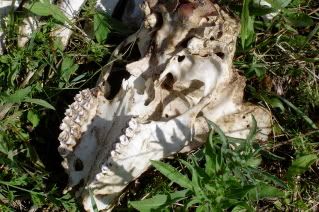
I spent the weekend on a farm, where I spent time learning the rules to card games (or, more importantly, how they are decided), and eating ice cream with fresh young strawberries. Also there were field trips to sheds full of antiques, unexpected patches of lady slipper orchids, and this here skeleton. According to people more knowledgeable than me, it was once a doe. She was an adult; her teeth say so. DeathRay found her lying in a field. Her skeleton was in pieces, the jaw separated from the rest of the face, the limbs gone. His aunt claimed that the dogs had been bringing home “mystery meat” all season; we know where those legs went, now.
I ran through weeds just so I could photograph her before DeathRay quickly and efficiently split her spine into manageable pieces with the sharp edge of a shovel and his boot. I knelt down in the grass to get this view. I wished for a macro lens, so I could get all the little bubbles in the bone made visible by one broken rib. Up close, she still smelled like meat.
She was also smaller than one might imagine. “People think of them as big, like horses,” the man who had dated her body said. “But they’re not. When you look for them, you have to look low.” He made a gesture with the flat of one hand, dropping it so we could see how low to the ground they really are. I know how they feel, I wanted to say, but didn’t.
We saw a lot more skeletons over the weekend, of the extended phenotype variety. Ancient cars, empty jam jars, glass Christmas ornaments, chairs wired to ceilings or nestled together like Victorian beaver dam, baptismal gowns slowly turning from white to ivory in a darkened closet. Later we talked about photo albums with no names or dates, mystery people sandwiched between pages of books that fit nowhere on standard shelving units. In a lot of ways, this is my favourite part of family gatherings: that time when everyone starts piecing together the lore and memory and hearsay into some comprehensible narrative. It’s hypertext made into the flesh from which it sprang, in which all the stories are connected, wiki-fied by our own frustrating inability to tell a straight story or remember things in order or without bias. We compensate for a lack of knowledge with a surplus of story, and suddenly the past becomes sensible, or the future predictable.
Nevertheless, for all our plotting and planning and imagination and machination, this is how we all end up. Maybe not in a field, maybe not dog food, but this is it. Fragile. Skeletal. Dignified in our ultimate anonymity, like a prim and proper picture in an album with no names, like a hollow dress, like a story broken into pieces, scattered in the weeds of someone else’s memory and and occasionally chewed on during long winters or rainy afternoons.